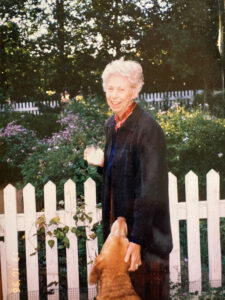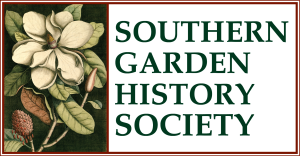On August 20, 2021, Jane Campbell Symmes, a member of SGHS since its founding in 1982, died at Cedar Lane Farm outside Madison, GA. She and husband John purchased the house and surrounding two hundred acres in 1966. As Jane described the farm years later in The American Woman’s Garden:
Cedar Lane came into existence because John, my late husband, wished to grow distinctive trees and shrubs for the nursery industry, and I had always wanted to restore an old house. . . . The acreage included an old spring smothered in honeysuckle, and an 1830s “plantation plain” house, stacked to the ceiling with bales of hay.
They began at once to restore the house, design the nursery, and lay out the gardens. For the house, which had not been significantly modified since its building, Jane and John chose to change as little as possible. If elements were missing, such as a door or molding, they copied and reproduced from the pieces that remained. To match the color of original clay mortars, they mixed clay into the cement.
For the nursery, Jane and John chose to grow plants indigenous to the southeastern United States as well as historical and non-native plants grown in the Georgia Piedmont before 1850. Much of Jane’s research into plants for the nursery dovetailed with her work on the gardens of the Tullie Smith House at Atlanta History Center. She and close friend Florence Griffin and other SGHS founders researched nineteenth century books and correspondence and then found the plants described in cemeteries, abandoned tenant houses, and other house sites. Jane was able to take cuttings from the plants they found and propagate them at the nursery.
Jane developed a catalogue of the plants the nursery carried, listing species by date of introduction and common usage. In the 1990s Jane shared with me several of the plants that she had grown and introduced into the trade, including the native honeysuckle selection, Lonicera sempervirens ‘Cedar Lane’ and the yellow sweetshrub, Calycanthus floridus ‘Athens’, which thrive in my garden in Maryland. Jane’s close friend and horticultural colleague, Rick Crown, described the provenance of ‘Athens’:
Jane and I made a collecting trip to Mary Hart Brumby’s garden in Athens to get cuttings from a rare yellow sweetshrub there. [Years before] when the demolition of the Lampkin-Mell House threatened the planting, Mary Hart Brumby and Augusta DeRenne dug up the shrub [yellow sweetshrub] and each planted some of it in their gardens.
For the gardens, Jane and John placed the flower garden with boxwood edged beds on the west side of the house and a kitchen garden to the east. Behind the house, to the south, they planted a long perennial border with an orchard and vegetable garden beyond.

While Jane was restoring and sleuthing and planting, she was also raising daughters Jeanne and Anne (both SGHS members and deeply knowledgeable of historic gardens), spearheading the work of the Georgia Trust, the Madison-Morgan Cultural Center, and the Madison-Morgan Conservancy, while serving as a SGHS board member, committee head, adviser, and host. Many of us remember the SGHS visit to Cedar Lane on the Saturday afternoon of the 2008 Athens annual meeting, described by Staci Catron:
A highlight of the afternoon Madison tour was the visit to Cedar Lane Farm. . . . Today, the grounds feature an herb garden, a woodland garden with more than 140 native species, a conifer collection, a boxwood garden, a mixed border with over 65 species, and a garden room containing a box-edged grass oval surrounded by a mixed planting of shrubs and perennials.

From attending the early SGHS organizing board meeting in October 1982 to overseeing revision of SGHS bylaws in 1993 to agreeing to serve as an honorary board member in 2012, Jane has guided and enriched the course of the society for decades. She embodied our vision to raise awareness and promote scholarship of historic gardens, and she focused our mission to celebrate the beauty and diversity of the South’s historic gardens and encourage their preservation. She did all of this with a joyous spirit that made anything seem possible.
Endnotes
- Rosemary Verey and Ellen Samuels, The American Women’s Garden (Boston: Little, Brown, 1984), 31.
- Treadwell Rice Crown, “Known and Grown: Plants and Plantings of Cedar Lane Farm,” Homecoming: The Sixth Henry D. Green Symposium of the Decorative Arts; Georgia Museum of Art, University of Georgia February 2-4, 2012, 66.
- Staci Catron, “‘High Cotton & Tall Columns,’ SGHS Annual Meeting Review,” Magnolia, Vol. XXII, No. 1, Summer-Fall 2008, 8.
Feature photo credit: Van Jones Martin, from Madison: A Classic Southern Town. The Historic Madison-Morgan Foundation


Bill Funkhouser
I just heard the sad news about Jane. I knew her many years ago, bought plant for my garden center from her, enjoyed our visits and always learned something about gardening, plants, propagating and more. Her daughter Jeanne was also a friend that, like Jane, I unfortunately lost touch with many years ago when I moved from Georgia. I am so thankful to have known Jane and so appreciate the impact she had throughout her life.